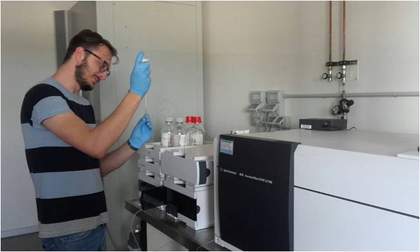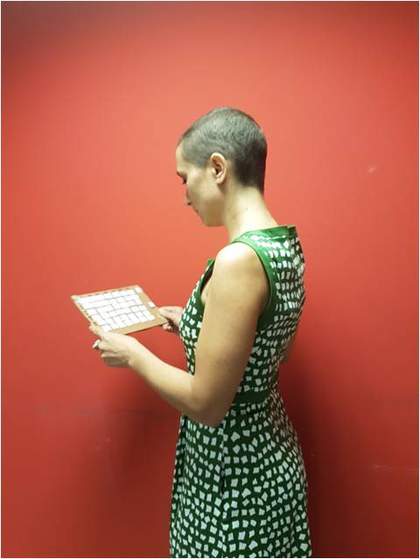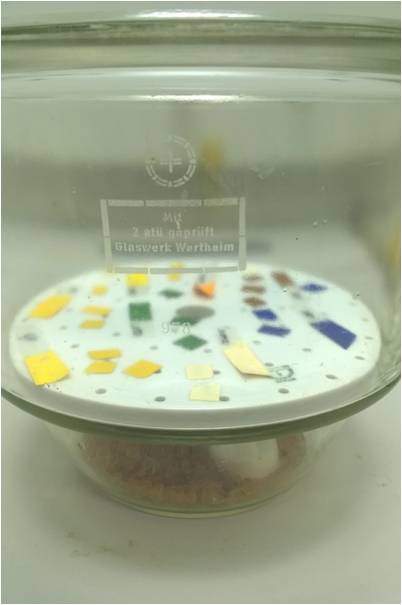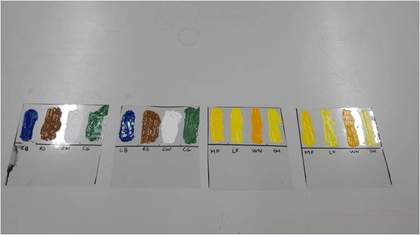An oil paint is a mixture of pigment which gives the paint its colour, additives which give the paint its buttery texture and help it dry, and extenders which give the paint extra bulk. These ingredients also influence how oil paints will age and change with time. We already see evidence for some of these changes on paintings and other artworks from the twentieth century. For example, some pigments slowly fade when exposed to high levels of light which can result in subtle colour changes, and it is common to see age cracks in old oil paintings which result from a combination of chemical and physical changes to oil paint films.
There are many other changes that can occur, e.g. ‘delamination’ or peeling paint, and some oil paints have even started to drip after they had dried! Some twentieth and twenty-first century oil paintings are also proving to be sensitive toward water and cannot be cleaned easily after becoming soiled through dirt depositing on paint surfaces.
Scientists understand that aged oil paints are complex chemical systems and they can study the various components of this system using specialised analytical techniques. Investigating oil paints at the molecular level allows us to make sense of some of the changes that occur as oil paintings and oil painted works of art age. It also helps conservators make informed decisions about the best way to conserve and look after works of art.
As mentioned, the chemical makeup of an oil paint changes significantly as it dries and ages and therefore contains many organic molecules which originate from the oil binder used to make the paint. These include a series of lipid (fat/oil) molecules known as glycerides, free fatty acids, dicarboxylic acids and other low molecular weight oxidation products. Metal soaps are also often present, which form from reactions between the oil binder and the pigments used in the paint. Rather confusingly, metal soaps are also a type of additive used by paint manufacturers for various reasons and separating the added materials from those formed within the paint over time can be hard to do!
Scientists study these types of changes in many ways. Spectroscopic techniques involve looking at specific chemical bonds which can help identify pigments, extenders as well as the broad chemical class of the binding medium (e.g. lipid, carbohydrate, protein etc). Chromatographic techniques give us more information where molecular components are separated out according to their size, and mass spectrometric techniques help us to identify specific chemicals present in the paints.
The main aim of CMOP’s Work Package 3, entitled ‘Chemical and physical analysis of degradation phenomena of modern oil paints and paintings’, led by the Department of Chemistry of University of Pisa (Italy) is to relate various ageing phenomena to the chemical composition of oil paints down to the molecular level where possible.
To do this, analytical methods were developed to tackle the following questions:
- Which binders and low concentration additives are present in modern oil paints.
- How pigment(s), additives and the environment influence the chemical composition of oil paint films as they dry and age.
- How the molecular composition of oil binders and additives relates to water sensitivity and other degradation phenomena, which can affect how works of art can be conserved.
Previous research has indicated that free fatty acids and metal soaps are related to the behaviour of oil paint as it ages. The University of Pisa have adapted and refined currently available procedures using High Performance Liquid Chromatography (HPLC) coupled with tandem mass spectrometry (HPLC-ESI-Q-ToF), infusion-high resolution mass spectrometry (ESI-Q-ToF) and gas chromatography-mass spectrometry (GC/MS).

Fig.1 Researcher Jacopo La Nasa performs chemical analysis of CMOP paint samples by means of HPLC-ESI-Q-ToF system, at the Department of Chemistry and Industrial Chemistry of the University of Pisa
One existing procedure (based on HPLC-ESI-Q-ToF) used to study solvent extracts of oil paint samples to explore their glycerides (main part of the oil) and oxidation products1 , was modified to improve the detection of free fatty acids, which are an important component of oil paints as they age. This new procedure allows us to separate and successfully quantify the free fatty acids in presence of mono-, di- and triacylglycerides without altering the whole glyceride profile, which provides a more true understanding of the components in the oil. This new analytical method also allows us to detect lower levels of these components than previous methods (as an example, limits of detection for free fatty acids are in the range 0.2-1.9 ng/g2 ), which may prove vital for our understanding of ageing processes, and to help minimise the effects of conservation treatments on modern oil paint films.
The HPLC-ESI-Q-ToF procedure however, does not allow the detection of fatty acids that exist in the metal soap form (such as zinc stearate). So, to evaluate these molecules, a new GC/MS method for the analysis of mixtures of free fatty acids and metal soaps in paint samples was developed. This approach used specific preparation steps for the selective GC/MS quantitative analysis of free fatty acids (using 1,1,1,3,3,3-hexamethyldisilazane or HMDS) and both free fatty acids and fatty acids soaps (using N,O-bis(trimethylsilyl)trifluoroacetamide or BSTFA)3 . In addition, the reaction conditions for the BSTFA process were optimized with a full factorial 32 experimental design using lead stearate and lead palmitate as model systems. This combined method now allows us to carry out qualitative and quantitative analysis of soaps (such as those based on stearic acid) formed/made from sodium, calcium, magnesium, aluminium, manganese, cobalt, copper, zinc, cadmium, as well as a soap made from a diacid (azelaic acid) and lead ions, called lead azelate.4 In this new method, the two preparation reactions are applied directly on the same paint sample in two different analytical steps, which allows us to discriminate between and quantify free fatty acids and metal carboxylates without any sample pre-treatment. That way we don’t lose any information!
The University of Pisa also used thermogravimetry (TGA – measuring the weight loss of samples with increased temperature) and constant temperature thermogravimetry (oxygen uptake analysis) to evaluate the effect of the presence of additives on the curing and general thermal behaviour of the paints (both freshly prepared from the tubes, and naturally and artificially aged). This helps us to understand how much of the paints are formed of a cross-linked polymer (which gives the paint strength) and how much of the paint has broken down into smaller molecules and fragments under different circumstances.

Figure 2: Associate professor Ilaria Degano looking at model paint samples at the Department of Chemistry and Industrial Chemistry of the University of Pisa.
These new approaches were applied for the full characterization of the oil fraction of the paint (i.e. the lipid profile and metal soap content) of several samples from reference paint layers prepared prior to CMOP project and in paint samples from case study works of art. Data analysis is currently being performed.
To study the influence of environmental conditions on paint chemistry, several model paint samples, which had aged naturally for ten years, were artificially aged at the laboratories of the Cultural Heritage Agency of the Netherlands (RCE) in Amsterdam. Artificial ageing was done by keeping the paint samples at 70°C in the dark, for nine weeks, in extreme relative humidity (RH) conditions (10% or 90%). Samples were then analysed to monitor the ageing pathways by infusion-high resolution mass spectrometry (ESI-Q-ToF) at the RCE. Analyses were performed by two masters programme students, Federica Parlanti and Fabiana Di Gianvincenzo, during their Erasmus+ Projects (each during 3 months), under the supervision of Dr Klaas Jan van den Berg of the RCE. The same set of paint samples were also analysed at the University of Pisa and the results will soon be published.

Fig.3 Artificial ageing chamber set to a high relative humidity, at the Cultural Heritage Agency of the Netherlands
These procedures were also used to analyse model paint systems, to investigate the relationships between the presence of metal soap additives, with the degree of hydrolysis of the oil (where the oil has been broken down), and several degradation phenomena associated with modern paints, in particular, water sensitivity. For this, a sub-set of samples were analysed in collaboration with Professor Aviva Burnstock and Donatella Banti (The Courtauld Institute of Art) at the University of Pisa in order to understand the role played by free fatty acids and metal soaps in water sensitivity. A scientific paper is under preparation.
A second sub-set of samples were selected by Judith Lee (CMOP Conservation Science Researcher, Tate) which included a collection of water sensitive and non-water sensitive oil paint samples, which were selected to correlate the chemical composition of the paints with their water sensitivity. The samples were analysed both by infusion-ESI-Q-ToF at the RCE and HPLC-ESI-Q-ToF at the University of Pisa, for the evaluation of the (lipid) glyceride profile.

Fig.4 Paint samples prepared at the Cultural Heritage Agency of the Netherlands
However, analytical chemistry is not only a matter of characterising samples and collecting chromatograms and spectra. Data interpretation is an equally important part of it, and can also be very complicated, especially when using analytical techniques capable of generating lots of specific, quantitative information for each sample. To help process these large, complex data sets, multivariate statistical analysis based on principal Component Analysis (PCA) was used. For this, Judith spent one week at the Department of Chemistry of the University of Pisa as part of our collaborative CMOP efforts to analyse the ESI data. This approach has enabled the identification of trends, similarities and differences between the water sensitive and selected non-water sensitive samples studied.
In parallel, the potential of chemical imaging techniques to study the long-term chemistry/kinetics of oil paint systems in terms of migration/aggregation of metal soaps is also being investigated. This research avenue involves exploring the possibilities of deep ultraviolet (DUV) photoluminescence (PL) microimaging as an emerging approach to characterise paint layers as a type of depth profiling, exploiting the potential of fluorescent tags to trace organic molecules distribution and migration. For this, a proposal to the DISCO beamline at the SOLEIL Synchrotron (Saint Aubin, France) is under preparation in collaboration with the IPANEMA platform (European research platform for ancient materials, France) and will be submitted in the next round (September 2017) – we’ll keep you posted!
Francesca Modugno, Ilaria Degano, Jacopo La Nasa, Anna Lluveras Tenorio, Celia Duce, Ilaria Bonaduce, University of Pisa
July 2017
